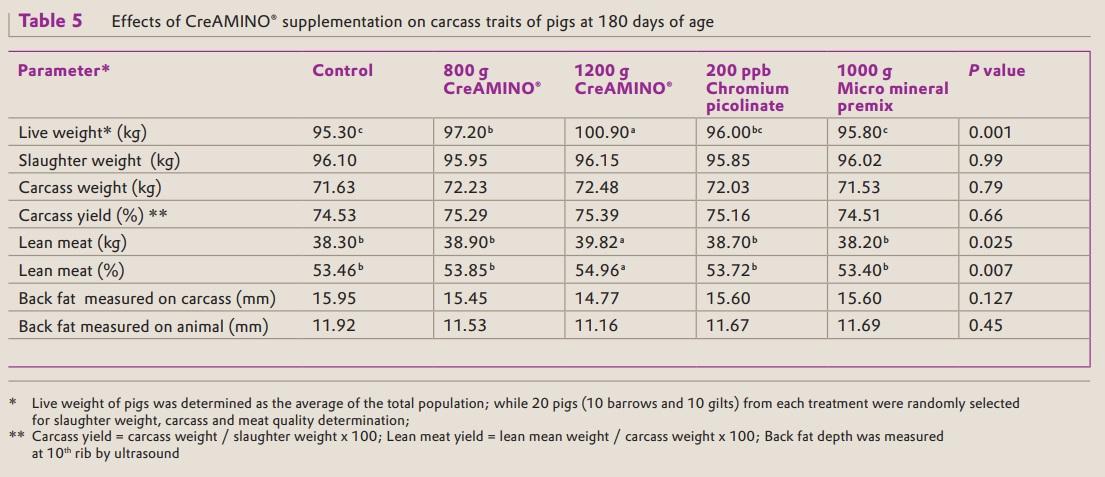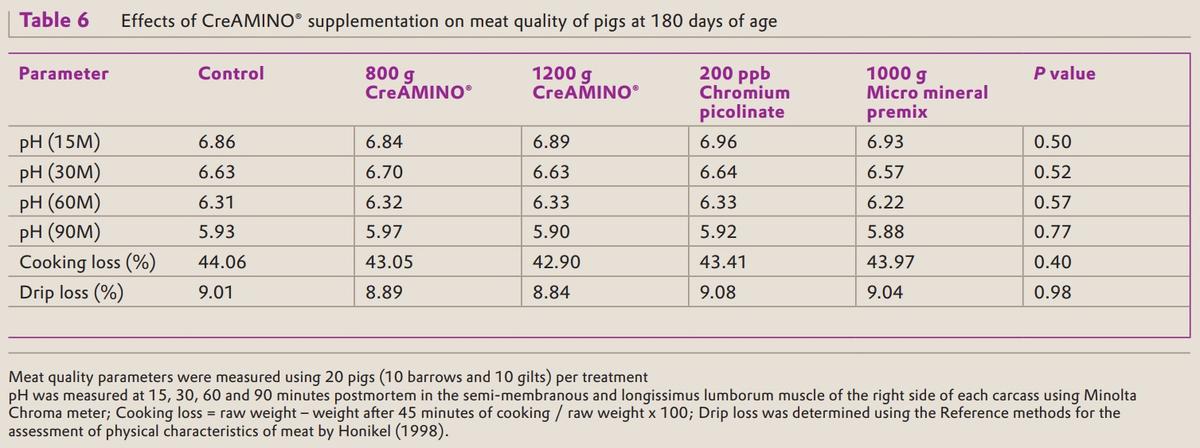
Content sponsored by:
Evonik Animal Nutrition
CreAMINO® supplementation improves growth performance and lean meat yield of pigs
Published: August 22, 2018
By: Dr. Meike Rademacher, Director Global Technical Sales Support, Nutrition & Care. Balachandar Jayaraman, Technical Service Manager, Nutrition & Care, Animal Nutrition.
Note: Creamino® is no longer distributed through Evonik. Since July 2020, Evonik is selling its own product GuanAMINO® to the market. Please contact us directly or get in touch with your local Evonik representative for more information or purchase
Conclusion
- Results of this study showed that the supplementation of CreAMINO® at 0.12% significantly improved the growth performance of pigs from starter to finisher stage.
- Lean mean yield was also significantly improved at 0.12% CreAMINO® supplementation, however meat quality was not affected.
Introduction and objective
Creatine is involved in cellular energy metabolism through the creatine and phosphocreatine system. This system functions as a backup to the adenosine diphosphate (ADP)/adenosine triphosphate (ATP) system to store and mobilize energy when required on short notice. Protein synthesis and deposition, and muscle contraction that require energy in the form of ATP is efficiently improved with the availability of phosphocreatine. Thus, improving the cellular creatine status through supplementation of a creatine source could enhance the overall energy metabolism and improve the performance and production of animals.
With the objective of determining the effects of CreAMINO® supplementation on growth performance, carcass and meat quality parameters of pigs, this study was conducted in collaboration with Institute of Animal Sciences for Southern Vietnam.
Materials and Methods
Pig diets based on commercial nutrient specifications from weanling to finishing stage (approx. 7 to 100 kg BW) were supplemented with CreAMINO®, chromium picolinate or commercial micro mineral premix (containing copper, zinc, manganese, iron, selenium and glycine) to create the dietary treatments. Dietary treatments included were: (T1) Basal diet (Control); (T2) Basal diet + 800 g CreAMINO®; (T3) Basal diet + 1200 g CreAMINO®; (T4) Basal diet + 200 ppb chromium picolinate and (T5) Basal diet + 1000 g micro mineral premix. A total of 600 weanling pigs [cross bred (Duroc x )] with initial body weight of approximately 7 kg were used in this study. Pigs were distributed to 10 replications of 12 pigs per replication (6 barrows and 6 gilts). A 4-phase feeding program was implemented with weanling feed fed at 30–60 d (7–18 kg), starter feed at 60-90 d (18–35 kg), grower feed at 90–120 d (35–55 kg) and finisher feed at 120–180 d (55–100 kg).
Feed intake, body weight and mortality were recorded during the study and subsequently used to calculate average daily gain (ADG) and feed conversion ratio (FCR).
At the end of the feeding trial, 20 pigs (10 barrows and 10 gilts) from each treatment were slaughtered for carcass and meat quality determination. Carcass, lean meat and back fat thickness were measured. Back fat measurement of live pigs was done at 9 to 11th rib by ultrasound machine at 180 days of age. In addition, post mortem pH, drip loss and cooking loss were measured.
Data were analyzed using Minitab statistical software and the significant differences among treatment means were compared using Tukey’s test.
Results
Ingredients as well as calculated and analyzed nutrient composition of the basal diet is presented in Table 1. The analyzed crude protein (CP) contents of pre-starter, grower and finisher diets were lower than the calculated contents. While the analyzed CP of starter was higher than the calculated content. Majority of the analyzed amino acid contents of starter, grower and finisher diets were higher than the calculated values. While in prestarter diets, the analyzed lysine, threonine and valine contents were lower than the calculated values.

The actual CreAMINO® content of the experimental diets are presented in Table 2. The analyzed CreAMINO® content of pre-starter diets 2 and 3 were within expected levels, while those of starter diets were slightly below expected levels. Grower diets have lower analyzed CreAMINO® content than expected levels. Analyzed CreAMINO® content of finisher diet 2 was within expected level while diet 3 was lower. Minimal amount of CreAMINO® were analyzed in diets containing chromium picolinate which were supposed to contain no CreAMINO®.

Average daily gain (ADG) and feed conversion ratio (FCR) of pigs are presented in Tables 3 and 4. There were no statistical differences between the treatments in pre-starter phase, but supplementation of 1200 g/MT significantly increased ADG of pigs during starter, grower, finisher and the over-allgrowthperiodfrompre-starter to finisher(Table 3). Similarly, FCR significantly improved at 1200 g CreAMINO® supplementation (Table 4).


Table 5 presents the effect of CreAMINO® supplementation on carcass parameters. Lean meat yield was significantly improved at 1200 g CreAMINO® supplementation. While other carcass parameters were not affected. Meat quality parameters like post mortem pH, drip loss and cooking loss were not affected (P>0.05) by dietary treatments (Table 6).


K. O Honikel, 1998. Reference methods for the assessment of physical characteristics of meat. Meat Sci. 49(4): 447-57.
Related topics:
Authors:

Influencers who recommended :
Caroline Gonzalez-Vega, Carlos de la Cruz Sierra and 1 moreRecommend
Comment
Share
PIG.dk
11 de septiembre de 2018
Interesting results. However, I wonder why the first feeding phase covered the interval 7-18kg? IMHO this interval makes no sense as it is way too long.
In the materials and methods, I would also appreciate if you mentioned which breed you used. Duroc is more a generic term as there is big variation in leanness of the Durocs depending on which breeding company they originate from.
In addition to the above you do not describe how lean meat is measured? The lean meat content of the pigs included in this study is very low but the way it is measured can, of course, have an effect on the results.
Recommend
Reply

Would you like to discuss another topic? Create a new post to engage with experts in the community.
Featured users

Fernanda Castro  Evonik Animal Nutrition
Evonik Animal Nutrition

Technical Services Manager in Poultry Nutrition and Global Sustainability Coordination inoSust Program
United States
United States





